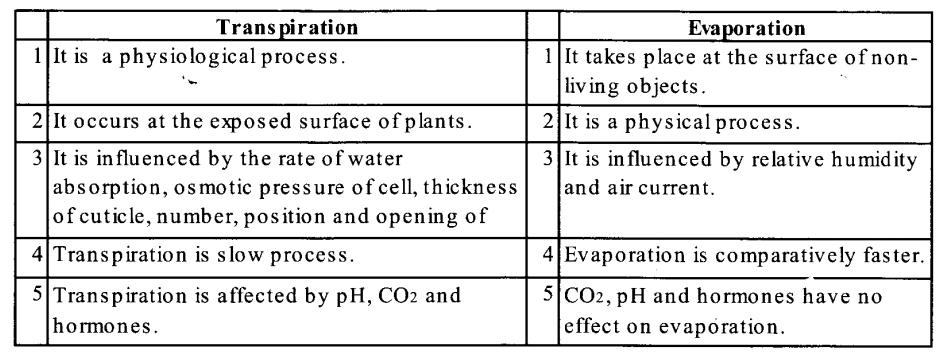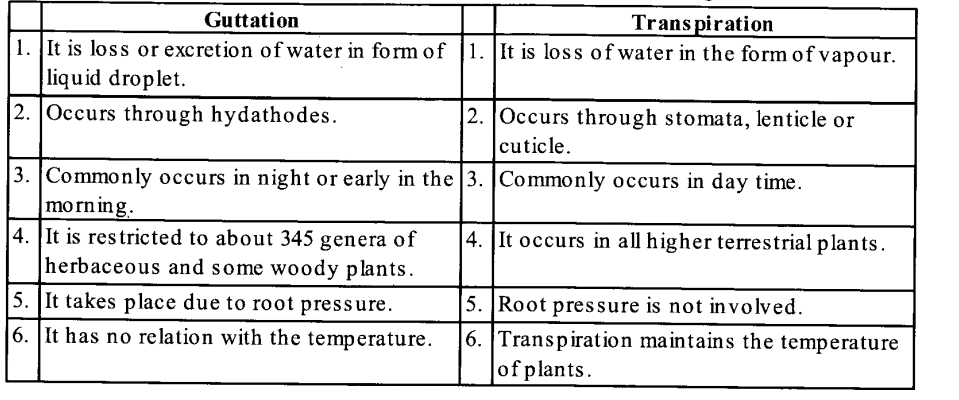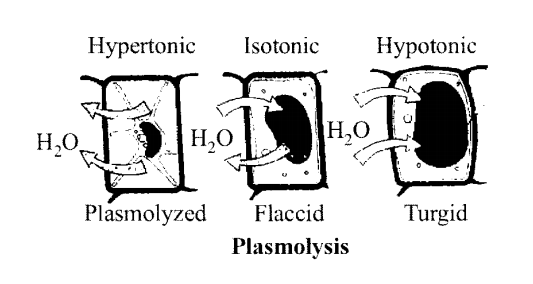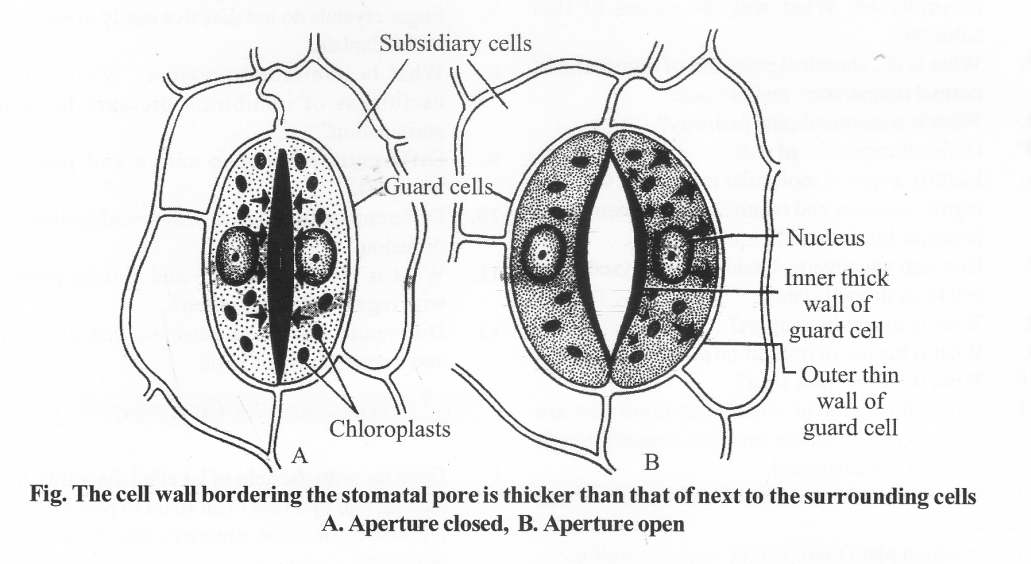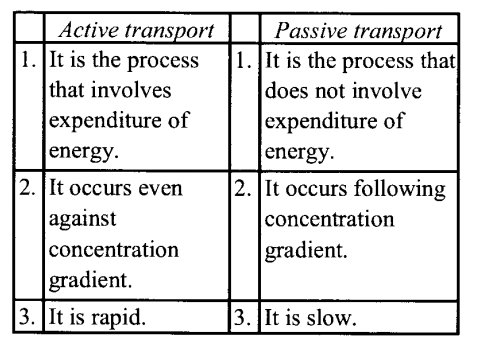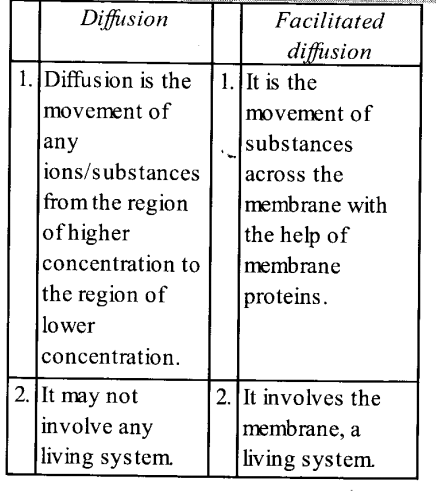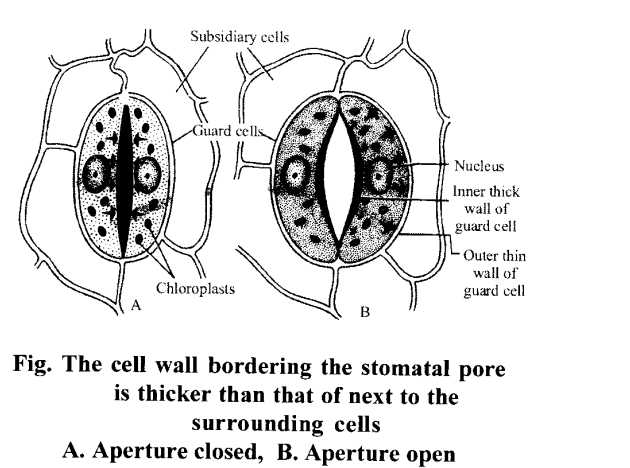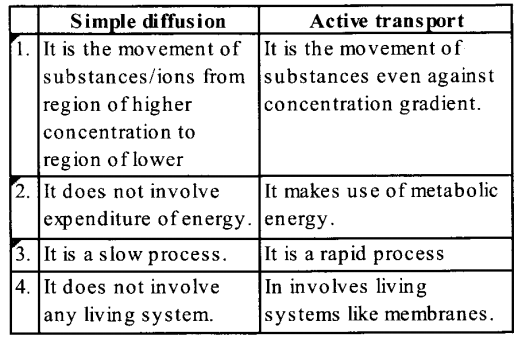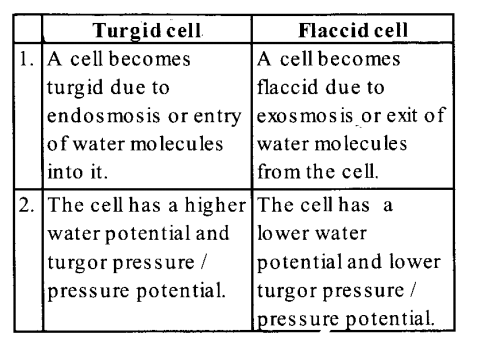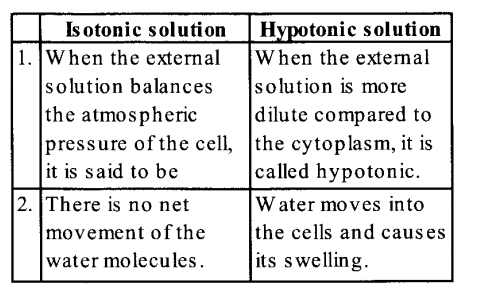NCERT Exemplar Solutions for Class 11 Biology Chapter 11 Transport in Plants
These Solutions are part of NCERT Exemplar Solutions for Class 11 Biology. Here we have given NCERT Exemplar Solutions for Class 11 Biology Chapter 11 Transport in Plants.
VERY SHORT ANSWER QUESTIONS
Question 1.
Smaller, lipid soluble molecules diffuse faster through cell membrane, but the movement of hydrophilic substances are facilitated by certain transporters which are chemically…….. .
Solution:
The movement of hydrophilic substances are facilitated by transporters which are chemically proteins. These proteins form porins, which are huge pores in the outer membranes of the plastids, mitochondria and some bacteria. These porins allow passage of small molecules through the membrane.
Question 2.
In a passive transport across a membrane. When two protein molecules move in opposite direction and independent of each other, it is called as………… .
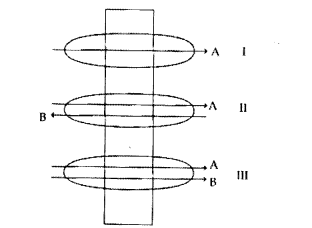
Solution:
Antiport which facilitates transport of molecules in both the directions across the membrane and their movement is independent of each other.
Question 3.
Osmosis is a special kind of diffusion, in which water diffuses across the cell membrane. The rate and direction of osmosis depends upon both………. .
Solution:
The rate and direction of osmosis is dependent upon the pressure and concentration gradient.
Question 4.
A flowering plant is planted in a earthen pot and irrigated. Urea is added to make the plant grow faster, but after sometime the plant dies. This may be due to ………… .
Solution:
The solution outside the plant is an hypertonic solution, and the plant cells are hypotonic in nature, so there is a gradual movement of water from plant cell to outside urea solution leading to plasmolysis of root cells and plant dies gradually due to exosmosis.
Question 5.
Absorption of water from soil by dry seeds increases the, thus helping seedlings to come out of soil.
Solution:
Imbibition of water by seed materials as starch and protein, pushes the seedlings out of the soil causing the seed to swell and increase of imbibition pressure inside the seed, contributes for germination of seeds.
Question 6.
Water moves up against gravity and even for a tree of 20 m height, the tip receives water within two hours. The most important physiological phenomenon which is responsible for the upward movement of water is………. .
Solution:
Transpiration pull is the physiological phenomenon which is responsible for the upward movement of water in tall trees the water molecules transpire from stomata, which pulls water molecules upward to the leaf from the continuous chain of water molecules carried by xylem
Question 7.
The plant cell cytoplasm is surrounded by both cell wall and cell membrane. The specificity of transport of substances are mostly across the cell membrane, because……… .
Solution:
Transpiration pull is the physiological phenomenon which is responsible for the upward movement of water in tall trees the water molecules transpire from stomata, which pulls water molecules upward to the leaf from the continuous chain of water molecules carried by xylem
Question 8.
The C4 plants are twice as efficient as C3 plants in terms of fixing C02 but lose only…. as much water C3 plants for the same amount of C02 fixed.
Solution:
C4 plants are twice as efficient as C3 plants in terms of fixing carbon in the form of glucose, but lose only half as much water as a C3 plant for the same amount of C2 fixed.
Question 9.
Movement of substances in xylem is unidirectional while in phloem it is bidirectional. Explain
Cell cycle is under genetic control and is a sequential event. Every cell prepares itself before it starts dividing. This preparation takes place in interphase stage of the cell cycle.
Solution:
Xylem is involved in the one way transport of water and minerals from soil to root ’ —> stem —> leaves. Several forces like imbibition, root pressure and finally transpiration pull. Act in this mechanism, It is a undirectional process as there is continuous loss of water at me body surface of plants.
The main function of Phloem is to transport food from source to sink where source is the part of plant responsible for food synthesis and sink are the organs requiring food for their growth and development.
These source and sink parts of a plants may vary in different phases of growth, thus the food needs to travel in both upwards and downward direction. So, phloem shows bidirectional movement of substances.
Question 10
Define water potential and solute potential.
Solution:
Water potential is a measure of free energy associated with water per unit volume (JM -3).
The water potential of pure (φw) at atmosp-heric Pressure is zero.
Additional of solutes reduce water potential (to a negative value). This reduces the of water concentration. Solutions thus have a lower water potential than pure water, the magnitude of this lowering due to dissolution of solute is called
solute potential of φs.
Question 11
An onion peel was taken and
(a) placed in salt solution for five minutes.
(b) after that it was placed in distilled water. When seen under the microscope what would be observed in (a) and (b) ?
Solution:
(a) When placed in salt solution an onion peel shrinks as water from cytoplasm of cell moves out of the cell to wards hypertonic solution.
(b) When again placed back in distilld water, cell regains it’s shape and absorbs water and become turgid.
Question 12
How does most of the water moves within the root?
Solution:
Water mostly flows in the roots via the apoplast pathway as the cortical cells are loosly packed and hence offer no resistance to water movement, through mass flow. This mass flow of water occurs due to adhesive and cohesive properties of water.
Like, symplast pathway is also involved in the movement of water molecules within the root (like, via endodermis to xylem).
Question 13
Transpiration is a necessary evil in plants. Explain.
Solution:
Loss of water in the form of water vapours from the surface of leaves of plant is called transpiration.
Transpiration a necessary evil because the plant continuously lose water in the vapour form from its body surfaces, Which creates a transpiration pull to absorb more and more water from soil through roots.
If water is not available to plants in soil, even then loss through transpiration does not ceasle, so plants sometimes sbfrws wilting.
Question 14
Describe briefly the three physical properties of water which helps in ascent of water in xylem.
Solution:
The following are physical properties of water that helps in ascent up to xylem.
Cohesive properties — Provider mutual attraction between molecules
Adhesive properties — Causes attraction of water molecules to polar surfaces (of tracheids)
Surface tension — Water molecules get attracted to each other more in liquid phase than in gas phase.
Question 15
Identify a type of molecular movement which is highly selective and requires special membrane proteins, but does not require energy.
Solution:
Facilitated diffusion’s is a highly selective passive process. Facilitated diffusion cause net transport of molecules from a low to high concentration. In facilitated diffusion special proteins help in movement of substances across the membrane without expenditure of ATP energy.
Question 16
Correct the statements.
(a) Cells shrink in hypotonic solutions and swell in hypertonic solutions.
(b) Imbibition is special type of diffusion when water is absorbed ‘*y living cells.
(c) Most of the water flow in the roots occurs via the symplast.
Solution:
(a) The cell swellSHORT ANSWER QUESTIONSter is adsorbed by living cells.
(c) Most of the water flow in roots occurs via the apoplast way.
SHORT ANSWER QUESTIONS
Question 1.
Minerals absorbed by the roots travel up the xylem. How do they reach the parts where they are needed most? Do all the parts of the plant get the same amount of the minerals?
Solution:
- The sabsorbed mineral are transported through the transpiration steam up the stem, to all parts of plant.
- The growing region of the plant, such as the apical and lateral meristems, young leaves, developing flowers, fruits, seeds and the storage organs are the chief sinks for the mineral elements.
- Uploading of the mineral ions occurs via fine vein endings through diffusion and active uptake by the cells.
- Xylem are involved in transport of inorganic nutrients where phloem transport only organic materials in plants.
- Mineral ions are frequently remobilised from older parts of plant like leaves to the younger regions.
- Most readily mobilised elements are phosphorus, sulphur, nitrogen, potassium, and some elements like calcium that forms the structural component are not remobilised.
Question 2.
Water is indispensable for life. What properties of water make it useful for all biological process on the earth?
Solution:
Following are the properties of water that make it useful for all biological processes.
(i) Water is the major solvent through which mineral nutrients enter a Plant from the soil solution.
(ii) It is an ideal solvent with neutral pH.
(iii) Water is the major constituent of protoplasm, it constitutes approximately 90% of the protoplasm.
(iv) Water acts as a medium for translocation of nutritive substances. Mineral nutrients are absorbed by the roots. Carbohydrates that are formed during photosynthesis are transported by water from cell to cell, tissue to tissue and organ to organ.
(v) Water is involved in photosynthesis in plants, as it incorporates hydrogen atom into carbohydrate and releases oxygen atoms as O2.
(vi) Water acts as an agent for temperature control. The specific heat of water helps plant in maintaining a relatively stable internal temperature.
(vii) Water is necessary for pollination in some plants in bryophytes and pteridophytes, water are essentially requires for the fertilisation process.
Question 3.
How is it that the intracellular levels of K+ are higher than extracellular levels in animal cells?
Solution:
The excitability of sensory cells, neurons and muscles is dependent on ion channels, signal transducers that provide a regulated path for the movement of inorganic ions such as Na+, K+, Ca2+, and Cl– across the plasma membrane in response to various stimuli.
Ion channels are ‘gated’ mplying that they may be open or closed. The Na+, K+, ATPase create a charge imbalance across the plasma membrane by carrying 3Na+ out of the cell for every 2K+ ion carried inside making the inside relatively negative outside.
The membrane is said to be polarised. That is the reason the intracellular levels ofK+ are higher than extracellular levels in animals cells.
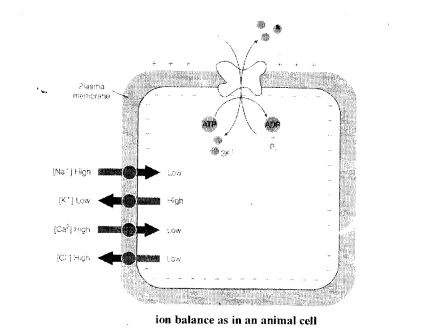
Question 4.
In a girdled plant, when water is supplied to the leaves above the girdle, leaves may remain green for sometime then wilt and ultimately die. What does it indicate?
Solution:
When water is supplied in a girdle plant to the leaves above the girdle, leaves may remain green for sometime because leaves can synthesise their own carbohydrate food through photosynthesis, they however, gradually wilt due to non-availability of water.
The system of xylem vessels from root to the leaf vein can supply the needed water during girding there is a possible loss of xylem vessels and the water supply is cut off, resulting in death of the plant.
Question 5.
Various types of transport mechanisms are needed to fulfil the mineral requirements of a plant. Why are they not fulfilled by diffusion alone?
Solution:
Ions, minerals and organic compound are transported in plants in various ways which include.
(i) Food substances ways which include v synthesised in leaves are translocated
downward towards root and stem.
(ii) Food is translocated upwards to the developing leaves, buds and fruits.
(iii) Radial transport of food occurs across the stem from the cells of pith, from cortex etc, towards epidermis.
(iv) Ions and minerals are transported upwards through xylem.
Diffusion is a slow process and allows movement of molecules only for short distances, so it cannot carry out the movements of organic and inorganic substances mentioned above. Therefore, a need arises for special long distance transport systems that permits and moves substances at a much faster rate, i.e., mas of bulk flow system through conducting tissues (translocation).
Question 6.
Will the ascent of sap be possible without the cohesion and adhesion of the water molecules? Explain.
Solution:
Ascent of sap is not possible without the cohesive and adhesive properties of water they play an important role in transport of water due to the following reasons
(i) Cohesion forces hold the water molecule together in the conducting channels, so vaccum is not created.
(ii) Adhesive forces acting between the water molecule and cellulose of cell wall make a thin film of water along the channels so that this film is pulled up by transpiration pull drawing more and more water upwards in the conducting channels from the root.
Question 7.
When a freshly collected Spirogyra filament is kept in a 10% potassium nitrate solution, it is observed that the protoplasm shrinks in size
(a) What is this phenomenon called?
(b) What will happen if the filament is replaced in distilled water?
Solution:
(a) The phenomenon, occurring is Spirogyra filament when placed in 10% potassium nitrate solution (hypertonic solution) is Plasmolysis. It occurs as water from the cell is drawn put to extracellular fluid causing the protoplast to shrink away from cell wall.
(b) The Spirogyra upon reabsorption of water, causes the protoplast to regain its original shape. This phenomenon is known as deplasmolysis.
Question 8.
What are ‘aquaporins’? How does presence of aquaporins affect osmosis?
Solution:
Aquaporins are integral membrane proteins which form pores or channels in the membrane.
The water flows is more rapid through these pores to inside of the cell, as compared to the process of diffusion.
These are plumbing systems of the cells. They selectively conduct water in and out of the cells, while preventing the passage of ions and other solutes.
Question 9.
ABA (Abscicis Acid) is called a stress hormone.
A.How does this hormone overcome stress conditions?
B. From where does this hormone get released in leave?
Solution:
A. Stress hormone ABA (Abscisic Acid) induces closing of stomata, whenever there is scarcity of water available to the plant. This prevents the loss of water through transpiration by leaves. It also increases the tolerance of plants to various kinds of stresses.
B. (ABA) is released or transported from the stem apices to leaves.
Question 10.
How is facilitated diffusion different from diffusion?
Solution:
Difference between cytokinesis in plant cell and animal cell is as follows.
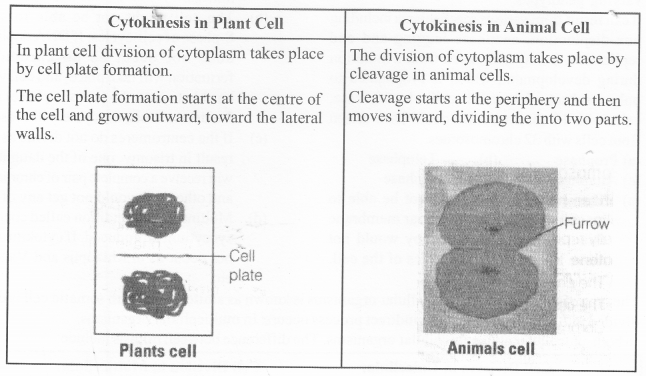
Question 11.
Observe the diagram and answer the following.
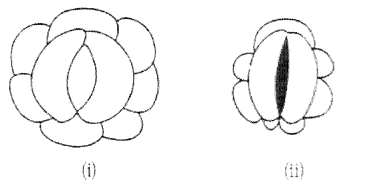
(a) Are these types of guard cells found in monocots or dicots?
(b) Which of these shows a higher water content (i) or (ii)?
(c) Which element plays an important role in the opening and closing of stomata?
Solution:
(a) The guard cells that are bean-shaped are
found in dicot plants.
(b) The guards cells in figure (i) are turgid as, they pull the inner wall of the cell outside thus, they have more water in figure (ii) cells are flaccid, this condition results when cells lose water and close stomatal pore.
(c) The K+ ions move from neighbouring cells to guards cells, lowering their water potential and as a result the water moves inside making them turgid and thus opening stomata.
Question 12.
Define uniport, symport and antiport. Do they require energy?
Solution:
- For movement of substances the biological membranes have many mechanism.
- Some are active and some are passive. Specific membrane proteins are also involved for special types of transport mechanisms. These mechanisms include:
- Uniport is a membrane transport system by an integral membrane protein that is involved in facilitated diffusion.
- These channels open in response to a stimulus for free flow of specific molecules in a specific direction. These channels transport molecule with a solute gradient without energy expenditure.
- Symport involves the movement of two or more different molecules or ions, across the membrane in the same direction, with no expenditure of energy.
- Antiport is called exchanger. This integral membrane protein is involved in secondary active transport of two or more different molecules or ions across the membrane in opposite directions, without affecting the transport of other molecules.
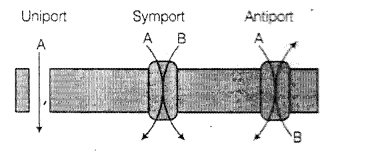
LONG ANSWER QUESTIONS
Question 1.
Minerals are present in the soil in sufficient amounts. Do plants need to adjust the type of solutes that reach the xylem? Which molecules help to adjust this? How do plants regulate the type and quantity of solutes that reach xylem?
Solution:
- Plants do need to adjust the type and quantity of solutes that reach the xylem.
- The transport of proteins in endodermal celr help in maintaining and adjusting solute movement.
- The minerals are present in soil as charged particles with a very low concentration compared to that of roots, and thus cannot be completely transported passively across the cell membranes of roots hairs.
- Minerals are thus transported both by active and passive processes, to the xylem.
- Upon reaching xylem, they are further transported, upwards to sinks through transpiration stream.
- At the sink regions mineral ions are unloaded through diffusion and active uptake by receptor cells. The mineral ions moving frequently through xylem include.
(i) Sulphur and Phosphorus in small amounts are carried in organic forms.
(ii) Njtrogen travels in plants as inorganic ions N02 and N03 but much of the nitrogen moves in the form of amino acids and related organic compounds.
(iii) Mineral ions are frequently remobilised particularly from older senescing parts. Older dying leaves export much of their mineral content to younger leaves. Similarly, before leaf fall in deciduous plants, minerals are removed to other parts.
The most readily mobilised elements are phosphorus, sulphur, nitrogen and potassium. Structural components elements like calcium are not remobilised.
Question 2.
Plants show temporary and permanent wilting. Differentiate between the two. Do any of them indicate the water status of the soil?
Solution:
The loss of turgidity of leaves and other soft aerial parts of a plant causing dropping, folding and rolling of non-woody plants is wilting. It occurs when rate of loss of water is higher than the rate of absorption.
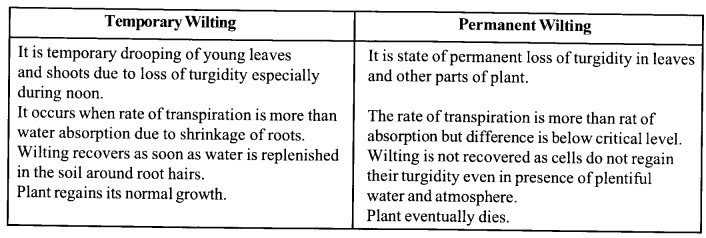
We hope the NCERT Exemplar Solutions for Class 11 Biology at Work Chapter 11 Transport in Plants, help you. If you have any query regarding NCERT Exemplar Solutions for Class 11 Biology at Work Chapter 11 Transport in Plants, drop a comment below and we will get back to you at the earliest.

